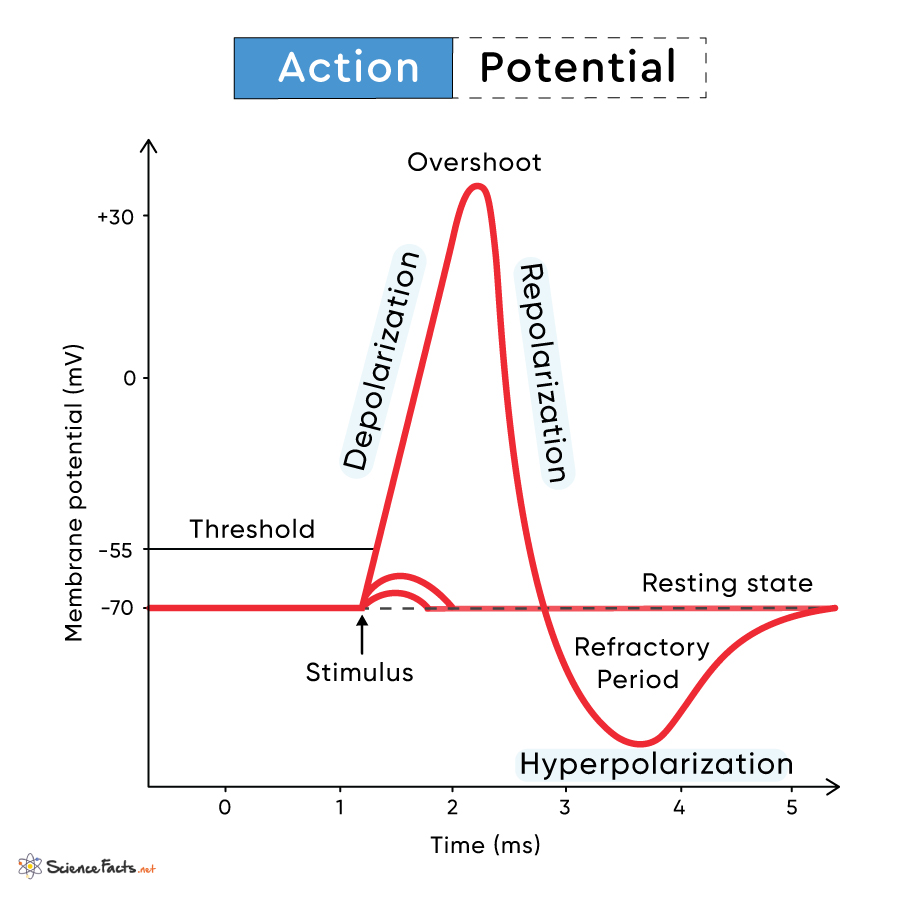An action potential is a sudden rise and fall in membrane voltage or potential of a neuron in response to a stimulus. It is a temporary shift in the neuron’s resting membrane potential when it sends information down the axon away from the cell body. Only neurons, muscles, and some endocrine cells can generate an action potential, a property called excitability. For example, when we smell the odor of deodorant, the olfactory neurons in the nose fire action potentials.
How Does Action Potential Work
Propagating Action Potential
Purpose of Action Potential
However, this state is quickly changed by the action potential. The generation of an action potential is a series of orderly events that can be explained in three stages: depolarization, repolarization, and hyperpolarization.
1. Depolarization (Rising Phase)
Depolarization is a sudden change in the neuron’s resting membrane potential (-70 mV in amplitude) from its negative to positive internal charge due to the influx of Na+ ions inside the cell. During depolarization, the sodium channels open in response to a signal received by the dendrites. When the depolarization reaches about -55 mV, the neuron fires an action potential. The -55 to -55 mV is the threshold for generating an action potential. If the neuron does not reach this potential, it will not fire an action potential. Also, the size of an action potential is the same for a given neuron. During the resting state, the Na+ ions are more concentrated outside the neuron than inside by a factor of 10. Thus, with the opening of sodium channels, a rapid, passive influx of sodium ions inside the cell makes the membrane potential more positive. This state is the depolarized state of the membrane, moving the membrane potential toward zero. The concentration gradient is so high that Na+ ions enter the cell even after the membrane potential attains zero and reaches almost overshoots +30 mV, the peak of the action potential. It is the period when depolarization stops. During depolarization, the inside of the membrane tends to become more electropositive. The process continues till the potential gets closer to the equilibrium value.
2. Repolarization (Falling Phase)
Repolarization is restoring the negative internal charge or membrane potential following depolarization. This phase starts with the inactivation of the sodium channels and the subsequent opening of the potassium channels. As the membrane potential attains +30 mV, the voltage-gated channels specific to K+ ions open. Since K+ ions are more concentrated inside the neuron than outside, the opening of potassium channels results in a rapid, passive efflux of potassium outside the cell. This efflux causes the membrane potential to return toward the -70 mV value of the resting membrane potential.
3. Hyperpolarization
Hyperpolarization immediately follows repolarization. As the membrane repolarizes, the sodium channels de-inactivate and return to the initial state, ready to open after receiving a stimulus. The potassium channels also close but remain open long enough to undershoot as potassium moves toward its equilibrium potential of -80 mV. When the membrane potential becomes more negative than the default membrane potential, the state is called the hyperpolarized state. Thus a hyperpolarized state occurs due to the efflux of potassium ions and the closing of the potassium channels. Once both the channels close, the sodium and potassium pumps reestablish the proper ionic concentrations needed to receive a new stimulus and are said to be in a rest state. As the membrane attains the resting membrane potential, it is ready to trigger the next action potential. The end of the hyperpolarization phase also marks the end of one action potential cycle. However, before another cycle can start the cell has to go through a refractory period.
Refractory Period
The refractory period is the subsequent time period after an action potential is generated. During this period, the excitable cell cannot develop another action potential. There are two sub-phases during the refractory period: absolute and relative refractoriness. Absolute refractoriness is the phase that overlaps with depolarization and 2/3rd of the repolarization phase. A new action potential cannot develop during depolarization because the voltage-gated sodium channels are open. A new action potential is also impossible during early repolarization as the sodium channels are inactive. Absolute refractoriness is reversed when sodium channels reopen. In contrast, relative refractoriness is the period when the generation of the action potential is possible but only when the stimulus is super strong. This period overlaps the last 1/3rd of the repolarization phase. Propagation does not affect the quality of the action potential. Thus, the target tissue gets the same impulse no matter how far from the cell body. It is, therefore, an all-or-none response to stimuli. After generating the action potential, it propagates along the membrane, depolarizing the next part of the membrane. Thus, the action potential does not move but is self-regenerating. It generates a new action potential in the next segment of the membrane to propagate forward from the neuronal body through the axon to the target tissue. Because of the refractory period, action potentials are conducted in one direction. The action potential’s speed along an axon depends on the axon’s diameter and whether the neuron is myelinated. The larger the diameter, the higher the speed of propagation. The propagation is faster if an axon is myelinated, as it reduces friction and increases the thickness of the fiber. In some other cells, action potential activates intracellular processes. For example, in the muscle cell, it is the first step leading to its contraction. Action potential promotes the release of insulin in pancreatic beta cells.
